Vertical Integration: 80’s Fad or Health Care’s Future?
Few industries have been changing as quickly as health care. As it does, alliances become more important to growth. But does that mean undoing what has already been done?
(originally published by Booz & Company)What was the case for vertical integration between payors and providers in the first place? The economic logic was something like this: owning physicians gives a health plan greater influence over practice patterns and reduces the use of medical resources; owning hospitals allows an insurer to control medical facility capacity and generate lower unit costs; and combining insurance, physician and hospital components under one entity yields reductions in administrative costs by eliminating the "transaction police" that are necessary to monitor the "puts and takes" between these pieces of the value chain whenever they aren't under common ownership. Taken together, these three sources of savings were argued to give the vertically integrated health plan a sustainable cost advantage over traditional/contractually structured competitors. (See Exhibit I.) Moreover, vertical integration of payor and provider functions was said to facilitate the tighter "coordination of care" needed to deliver differentiated clinical quality. In short, by "aligning economic incentives" between the financing and delivery of care, the vertically integrated health plan was supposed to create superior value in the health care marketplace.
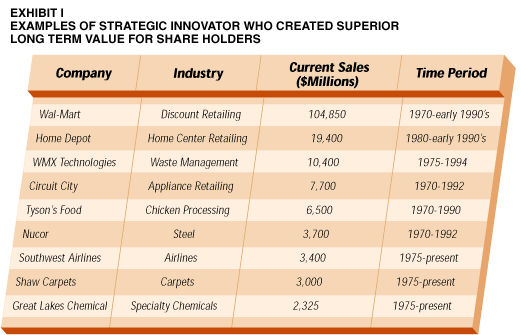
Many industry participants found these arguments compelling and throughout the 1980's formed health care companies that were, to varying degrees, vertically integrated. Kaiser continued to expand its owned hospitals and contracted exclusively with the Permanente Group; Aetna built staff model clinics across the country; CIGNA also built staff model clinics and acquired the Lovelace integrated health system; FHP owned health plans, physician clinics and hospitals; Prudential invested in the "group model" H.M.O. and owned/managed clinic assets; Humana owned health plans and hospitals; and many regional provider systems like the Henry Ford Hospital System, Sentara and Geisinger started up their own H.M.O.'s. The approach that each of these players pursued was different, but all had the common aim of assembling key payor and provider components under common ownership. (See Exhibit II.)
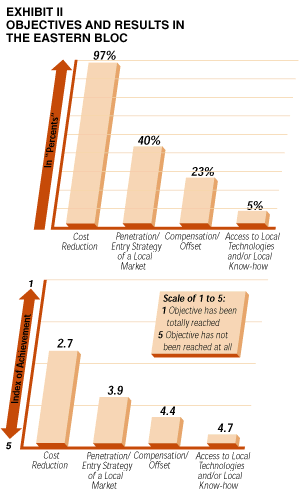
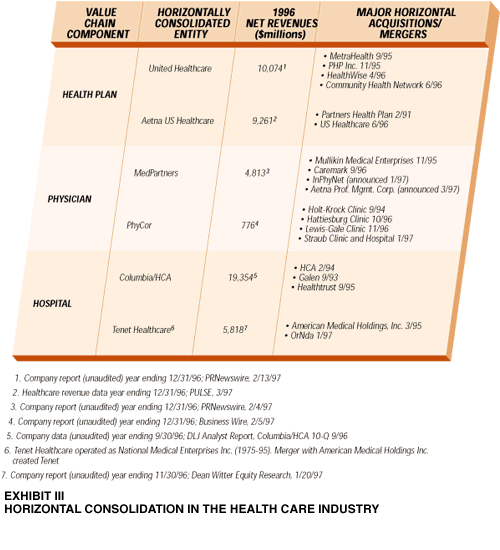
But in the 1990's, the industry is reversing course. Vertically integrated entities are now "unwinding" system components. Humana's early sell-off of its hospital business, Galen, has since been followed by a number of other high-profile cases. Kaiser in many markets is now renting hospital capacity rather than owning it, and has started to contract with non-Permanente physicians to supplement its core networks. FHP has recently sold its hospitals and created a separate subsidiary for its group practice, ostensibly as a first step toward spinning it off. CIGNA has divested its southern California clinics to Caremark (now MedPartners). And Aetna has recently announced the sale of its physician practice management company, along with most of its HealthWays Family Medical Centers and affiliated group practices, to MedPartners. Instead of vertically integrating, industry leaders are aggressively pursuing horizontal consolidation, as the cases of United Healthcare/Metra, Aetna/US Healthcare, Columbia/HCA, numerous California-based H.M.O.'s and others make abundantly clear. (See Exhibits III and IV.)
So what explains this recent shift from vertical integration to horizontal consolidation? Several factors are at play.
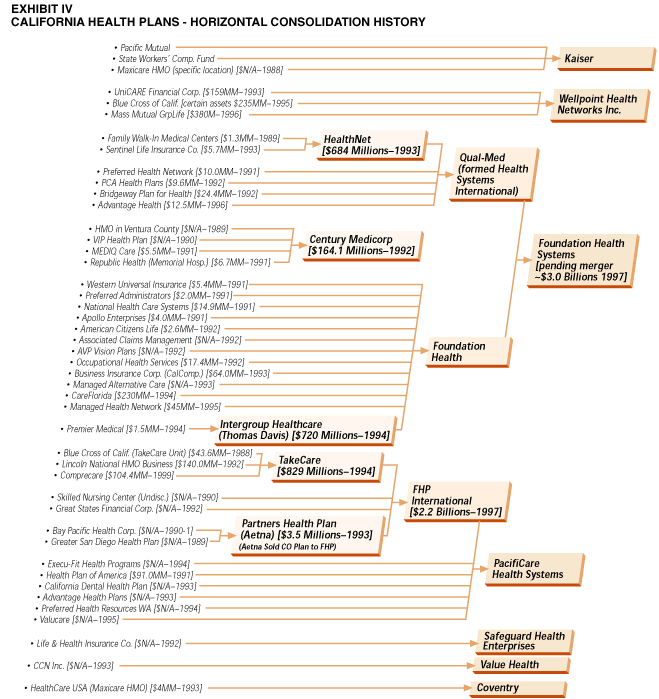
Innovation in Provider Reimbursement: Innovation in provider compensation mechanisms -- moving beyond fee-for-service reimbursement -- has allowed non-vertically integrated insurers to "mimic" the economics of physician and hospital ownership. US Healthcare, for example, has developed a modified capitation program that pays out physician performance incentives based on key cost and clinical indicators. Similarly, US Healthcare's CapTainer reimbursement program for hospitals supplements base payments with annual performance bonuses that are calculated on the basis of service and clinical quality measures. The combination of capitation and performance bonuses has enabled US Healthcare and other insurers to influence provider practice patterns in a way that is consistent with lower costs and higher quality -- all without actually owning the physicians and hospitals in their networks.
Too Much of a Good Thing: Government-sponsored expansion of provider capacity in the 1950's, and the rise of "third-party payment" insurance plans (employer-sponsored, Medicare and Medicaid) throughout the postwar era, generated explosive growth in the availability and consumption of medical services in America. However, as "managed care" has increasingly taken hold, with its focus on controlling the utilization of medical services, a sharp and growing imbalance has been created between the supply and demand of medical services. Excess provider capacity -- particularly in the form of overbedding and an oversupply of specialists -- has created a "renters' market" for medical services in which insurers can rent physician and hospital services at levels well below the average costs associated with owning them. Provider overcapacity, then, has created market conditions in which insurers can rent providers cheaper than they can vertically integrate and own them.
Refocusing on Core Competencies: It has taken leading provider institutions decades to learn how to manage an integrated physician and hospital organization effectively. Not surprisingly, insurers that entered the provider ownership and management business in the 1980's have found it difficult to get up to speed quickly. Stung by the difficulties of trying to expand into new pieces of the health care value chain, insurers have more recently abandoned their forays into provider ownership and management and refocused on their core competencies -- most notably by deepening their expertise in health plan management and expanding their ability to support the efforts of providers to improve practice patterns (for example, by investing in information technology and performance reporting). Vertical integration, it seems, may make some sense in theory, but has proven difficult in practice.
Emergence of New Entrants: The rise of new industry participants that have focused on developing core expertise in managing provider components and other pieces of the health care value chain has further reinforced the decision of insurers to "stick to their knitting." Physician practice management companies (P.P.M.'s) -- such as PhyCor, Coastal and MedPartners -- now specialize in creating economic value by owning and managing physician practices. Relatively new and now massive hospital management companies like Columbia/HCA are similarly creating economic value by specializing in the elimination of excess capacity and the realization of scale economies. All of this means that insurers are increasingly finding themselves competitively disadvantaged in the business of owning and managing providers -- and can therefore "rent" physicians and hospitals cheaper than they can buy and run them.
Leveraging Technology: As a result of significant investments in information technology, insurers have been able to begin transitioning from expensive "real time" oversight of providers to more efficient forms of performance tracking and reporting. Electronic Data Interchange interconnectivity and advancements in case-mix and severity-adjustment algorithms have allowed insurers to track and report individual provider performance against peer group and regional/national norms. This has allowed insurers with contractually based provider networks to begin eliminating the need for the "transaction police" that have historically adjudicated event-specific interfaces between health plans and providers. Technology has therefore provided an alternative to outright insurer ownership of physicians and hospitals as a means of reducing administrative costs.
The Impatience of Public Equity: Investing in owned provider capacity is capital intensive. It is also often slow to bring on line -- forming medical group practices doesn't happen overnight, and the certificate-of-need requirements for medical facilities in many states prolong the time to market for those wanting to build additional capacity. Acquisitions, while typically faster than building provider capacity, still fail to guarantee their new owners a steady flow of premium-paying members. This raises the fundamental problem of matching owned provider capacity to membership growth -- with mismatches in either direction negatively impacting earnings, as the recent case of Kaiser makes clear. While not itself a publicly traded company, Kaiser's troubled performance has soured Wall Street's interest in seeing other health plans pursue this approach to growth. Instead, Wall Street has applauded health plans that have captured dramatic near-term earnings growth through horizontal consolidation.
Creating Efficient Health Plans: Wall Street's focus on horizontal consolidation is grounded in the realization that, under current market conditions, significant value can be created by "aggregating" highly fragmented and inefficient health plans. "In-market" acquisitions have allowed insurers to capture several benefits: boost membership and use this increased leverage over providers to lower medical costs through deeper discounts; reduce administrative costs through improved scale economies in overhead functions and operations; capture capital efficiencies through shared investments in key capabilities such as information technology; and strengthen combined health plan performance by leveraging complementary areas of expertise. "Cross-market" acquisitions have had the added advantages of improving health plan positioning to serve large, multi-state accounts as well as establishing significant beachheads for future growth in attractive regional markets. Taken together, these benefits help explain why Wall Street has rewarded the earnings growth that leading health plans have been able to achieve through horizontal consolidation.
The Customer Has Spoken: The voice of the customer has also played a role in reversing the 1980's trend toward vertical integration. As medical inflation moderated in the 1990's, customers renewed their calls for choice and broader provider networks (access). To satisfy these preferences and grow market share, vertically integrated health plans were forced to expand their narrow networks. They had two options. They could add contracted providers. But this approach often compromised the tight control over selected providers that was the very source of their competitive advantage. It was also often "easier said than done" -- since an insurer's decision to "go vertical" often prompted unaligned providers to retaliate by setting up their own competing networks, thereby limiting the viability of independent contracting. The other option was to establish a broader network of owned providers. But this did not work either. Health plans did not have the membership needed to operate large fixed-cost networks profitably. And competing health plans resisted any invitation to use these proprietary networks for fear of disadvantaged pricing and service. In short, the customer wanted choice -- and vertically integrated health plans couldn't deliver it.
Clinical Quality -- "Waiting for Godot": "Cost" and "access" have typically been the primary drivers of health care purchase decisions, since "quality" has been notoriously difficult to define and measure. "Service quality" (claims payment and customer service cycle times, for example) and "clinical process quality" (credentialing procedures, medical policy and the like) are now both reasonably well defined and measured in the industry by the National Committee for Quality Assurance and other agencies. But "clinical outcomes quality" (i.e., the impact of medical services on member health status) remains more elusive and hence has tended to play a less prominent role in competition between health plans. A critical basis of competitive advantage that was originally postulated for vertically integrated health plans -- superior clinical outcomes quality -- has therefore gone largely untested, in terms of both whether integrated companies can actually produce these differentiated results and whether customers will change their enrollment patterns based on them. The current stage of evolution in the supply and demand of "health care quality," then, hasn't supported the need for vertical integration between payors and providers.
Back to the Future
Where does all of this leave us? Given the challenges of integrating health care financing and delivery under one roof, are we likely to ever see a return to strong forms of vertical integration? Once the current trend toward horizontal consolidation has run its course, excess capacity has been eliminated from the industry and there are super-regional or national health plans facing off against comparably scaled delivery systems, are we likely to see renewed interest in vertical integration? For example, will players such as United/MetraHealth and Columbia/HCA ultimately turn to vertically integrating with one another; will super-consolidated Blues eventually merge with players such as PhyCor, Coastal or MedPartners? Or will the health care value chain remain fragmented across discrete companies specializing in health plan versus delivery functions?
Under the current "reform-lite" regulatory environment, several factors seem likely to play a significant role in determining the future course of restructuring in the health care industry. These factors will have a major impact on the strategies and capabilities that industry participants will need to compete over the next five to 10 years. Specifically, these factors will, in our view, drive health plans and providers to reconsider vertical integration:
![]() First, once excess provider capacity has been sharply reduced, today's "renters' market" will evaporate and surviving delivery systems will be positioned to charge insurers uneconomic rents -- driving health plans to reconsider owning provider capacity.
First, once excess provider capacity has been sharply reduced, today's "renters' market" will evaporate and surviving delivery systems will be positioned to charge insurers uneconomic rents -- driving health plans to reconsider owning provider capacity.
![]() Second, once providers have completed their own horizontal consolidation and created dominant local delivery systems, their ability to pursue "direct contracts" with employers will raise the threat of "disintermediation" for insurers -- leading some plans to buy them.
Second, once providers have completed their own horizontal consolidation and created dominant local delivery systems, their ability to pursue "direct contracts" with employers will raise the threat of "disintermediation" for insurers -- leading some plans to buy them.
![]() Third, when insurers have capitalized on the value created by consolidating health plans, and earnings return to historic levels, there will be renewed interest in capturing margins on as much of the health care dollar as possible -- provider as well as payor pieces.
Third, when insurers have capitalized on the value created by consolidating health plans, and earnings return to historic levels, there will be renewed interest in capturing margins on as much of the health care dollar as possible -- provider as well as payor pieces.
![]() Fourth, once market share has been concentrated in a limited number of consolidated health plans, continued growth will become more difficult to achieve -- leading some insurers to try capturing differentiation through proprietary networks that they would then have the members to support.
Fourth, once market share has been concentrated in a limited number of consolidated health plans, continued growth will become more difficult to achieve -- leading some insurers to try capturing differentiation through proprietary networks that they would then have the members to support.
![]() Fifth, once "clinical outcomes quality" becomes a health care attribute that is well defined and measured, it may serve as another key basis upon which competing health plans are evaluated -- driving some to try capturing competitive advantage through vertical integration.
Fifth, once "clinical outcomes quality" becomes a health care attribute that is well defined and measured, it may serve as another key basis upon which competing health plans are evaluated -- driving some to try capturing competitive advantage through vertical integration.
![]() Sixth, once reigning health plans have defeated their adversaries in the consolidation battles of the 1990's, institutional memories of the painful lessons learned from earlier forays into provider ownership will have faded -- leading some to boldly "try it again."
Sixth, once reigning health plans have defeated their adversaries in the consolidation battles of the 1990's, institutional memories of the painful lessons learned from earlier forays into provider ownership will have faded -- leading some to boldly "try it again."
Columbia/HCA's attempted acquisition of Blue Cross/Blue Shield of Ohio, and others currently under negotiation, may prove the first of many renewed attempts at vertical integration between insurers and providers.
But it would be wrong to suppose that the future of health industry restructuring will offer participants only a stark choice between the two extremes of contractual relationships and outright ownership. In our view, the longer- term evolution of the health care marketplace is likely to often favor various economic arrangements that fall somewhere in the middle -- in the form of extended enterprise "alliances." As in other maturing industries, economic forces in the health care industry are driving increased specialization and fragmentation of the value chain. As a result, key capabilities are becoming increasingly diffused across separate companies -- driving the need to integrate a complex extended enterprise to create value. Competition in the future, we believe, will often no longer be between "companies" but between "value chains" -- one extended enterprise versus another. Alliances, often more so than contractual relationships or outright ownership, can help companies achieve competitive advantage by complementing their own core competencies with the differentiated capabilities of extended enterprise partners. (See Exhibits V and VI.)

A number of dynamic industries currently provide instructive examples of extended enterprise alliances in action. In the computer industry, for instance, General Instrument, Intel and Microsoft have formed an alliance to develop interactive broadband terminal equipment -- an alliance that creates value by producing new products and by reducing aggregate development costs and time frames. General Instrument brings valuable access to the set-top market for this alliance, while all three partners bring innovation skills and technology access in complementary areas (General Instrument in encryption and video compression, Intel in processor hardware and Microsoft in software). Through this alliance, these three partners have been able to leverage their complementary core competencies while sharing associated development costs and risks. This extended enterprise alliance is now competing with two other major alliances to develop the industry standard.
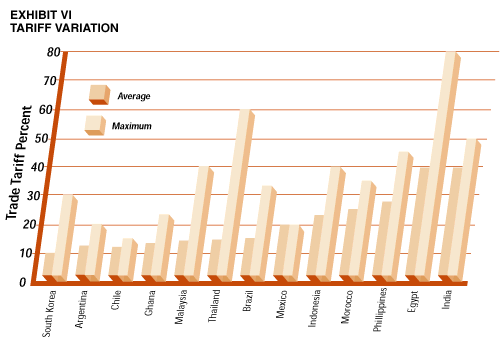
There are already early signs that some leading competitors in the health care industry are initiating and experimenting with various forms of alliances. Perhaps the most dramatic example is Aetna/US Healthcare's recently announced 10-year strategic partnership with MedPartners. This alliance will allow Aetna/US Healthcare's members to access MedPartners' affiliated physicians across the country. In announcing the deal, Aetna/US Healthcare stated that strategic alliances with selected providers will replace Aetna's former strategy of owning physician practices. Together, Aetna/US Healthcare and MedPartners will leverage their complementary expertise to define quality enhancement criteria and improve the health status of plan members. Oxford Health Plans, through its new Private Practice Partnerships, is another recent example of a "virtual" or alliance-based approach to integration with providers.
The critical challenge for industry participants today is essentially threefold: to understand the course of restructuring in their major markets, to determine the strategic approaches toward integrating key pieces of the health care value chain that are right for them (see Exhibit VII), and to build the competitively advantaged capabilities needed to execute chosen strategies effectively. Sorting out these issues raises a number of pressing questions for senior management: If I'm currently vertically integrated, should I unbundle the pieces and get into the horizontal consolidation game, or stick it out in anticipation of a return to market conditions that will be more favorable toward vertically integrated entities? If I'm currently pursuing horizontal consolidation across multiple markets, how will I know when these markets are ready to switch toward renewed interest in virtual or vertical integration? When my markets "flip," how will I know whether I should pursue vertical integration or more "virtual"/alliance-based approaches to partnering with providers? And, depending upon which approach I take, what key capabilities will I need to put in place to pull off my chosen strategy?
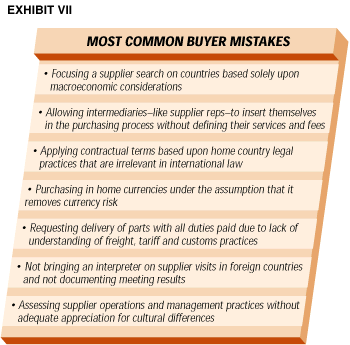
For those players in situations where alliances prove an important vehicle for value creation, essential new capabilities will need to be developed over the coming decade. Alliance-related expertise will be critical in several areas: identifying core competencies, screening extended enterprise alliance partners; defining/negotiating venture objectives and partner responsibilities; modeling financial arrangements; monitoring alliance performance; and devising conflict resolution mechanisms. (See Exhibit VIII.) Lessons learned from alliance activity in other industries suggest that experience -- "How many alliances do you have under your belt?" -- will be a significant driver of success.
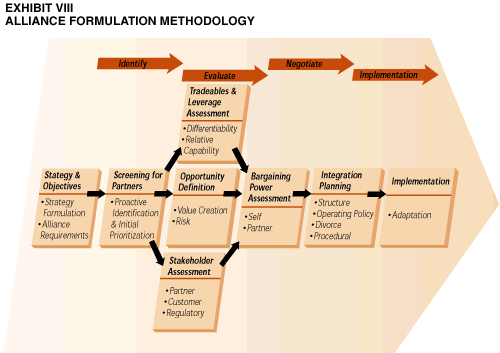
But if the results that are being achieved through alliances in other industries are any indication, advantaged alliance design and execution capabilities will be well worth developing for players in the health care industry. If this view is right, then it will often be through extended enterprise alliances, not just common ownership of payor and provider components, that the managed-care leaders of the future will seek to achieve sustainable competitive differentiation and profitable growth. ![]()
Reprint No. 97304
| Authors
David G. Knott, knott_david@bah.com David G. Knott is a vice president with Booz Allen Hamilton in New York. Dr. Knott leads the firm’s strategy work in the health services sector. |



